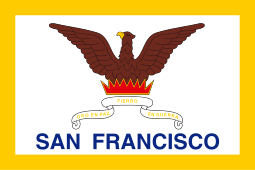University of San Francisco
| Latin: Universitas Sancti Francisci | |
Former names |
St. Ignatius Academy (1855) St. Ignatius College (1859) University of St. Ignatius (1912) St. Ignatius College (1919) |
|---|---|
| Motto | Traditional: Pro Urbe et Universitate (Latin) |
Motto in English |
Traditional: For City and University Current motto: Change the World From Here |
| Type |
Private nonprofit Carnegie Classification: Doctoral/Moderate Research and Community Engaged |
| Established | October 15, 1855[1] |
| Affiliation | Roman Catholic (Jesuit) |
| Endowment | $342.1 million (2017)[2] |
| President | Paul J. Fitzgerald, S.J. |
Academic staff | 1,193 faculty (fall 2016: 505 full-time, 688 part-time)[3] |
Administrative staff | 1,083 (fall 2016: 975 full-time, 108 part-time) [3] |
| Students | 11,080 (fall 2017)[3] |
| Undergraduates | 6,847 (fall 2017)[3] |
| Postgraduates | 4,233 (fall 2017)[3] |
| Location |
San Francisco, California, U.S. 37°46′46″N 122°27′07″W / 37.77944°N 122.45194°WCoordinates: 37°46′46″N 122°27′07″W / 37.77944°N 122.45194°W |
| Campus | Urban - 55 acres (22 ha) |
| Fight song | "Victory Song" |
| Colors | Green and gold [4] |
| Athletics | NCAA Division I – WCC |
| Nickname | Dons |
| Affiliations |
AJCU ACCU NAICU WSCUC |
| Sports |
15 varsity sports teams [5] (7 men's and 8 women's) |
| Mascot | The Don, a Spanish nobleman |
| Website |
www |
 | |
The University of San Francisco (USF) is a Jesuit Catholic university located in San Francisco, California, United States. The school's main campus is located on a 55-acre (22 ha) setting between the Golden Gate Bridge and Golden Gate Park. The main campus is nicknamed "The Hilltop", and part of the main campus is located on Lone Mountain, one of San Francisco's major geographical features. Its close historical ties with the City and County of San Francisco are reflected in the University's traditional motto, Pro Urbe et Universitate (For the City and University). The current motto is Change the World From Here. USF's Jesuit Catholic identity is rooted in the vision and work of St. Ignatius of Loyola, the founder of the Jesuit order.
University of San Francisco campuses
The University of San Francisco offers more than 230 undergraduate, graduate, professional, and certificate programs on its main Hilltop Campus. USF also offers programs at several additional campuses.[6]
The USF Downtown San Francisco Campus, which began in 2012 in the historic Folger Building at 101 Howard Street, offers the MBA and the Executive MBA, MBA Dual Degree programs, and master's degrees in Entrepreneurship and Innovation, Financial Analysis, Global Entrepreneurial Management, Nonprofit Administration, Organization Development, and Public Administration.[7]
The Orange County Campus, founded in the City of Orange in 1983, offers the Master’s in Sport Management and the Master’s in Nursing for Non-Nurses.[8]
The Pleasanton Campus, which began in 1986 in San Ramon, and moved to Pleasanton in 2012, offers a Bachelor’s in Management (Degree Completion), the Master’s in Nursing for the Registered Nurse, and the Master’s in Teaching with the Single or Multiple Subject Teaching Credential.[9]
The Presidio Campus, established at the San Francisco Presidio in 2003, offers the Master in Behavior Health, the Master of Public Health, and the Doctor of Psychology (PsyD) in Clinical Psychology.[10]
The Sacramento Campus, founded in 1975, offers the Bachelor of Science in Nursing, the Master of Public Health, the Master’s in Counseling with an Emphasis in Marriage and Family Therapy, and the Master’s in Teaching with the Single or Multiple Subject Teaching Credential.[11]
The San Jose Campus, established in 1980, offers the Master’s in Information Systems, the Master’s in Teaching with the Single or Multiple Subject Teaching Credential, the Master’s in Counseling with an Emphasis in Marriage and Family Therapy, and the RN to MSN Nursing/Clinical Nurse Leader.[12]
The Santa Rosa Campus, founded in 1989, offers the Master’s in Counseling with an Emphasis in Marriage and Family Therapy, and the Master’s in Teaching with the Single or Multiple Subject Teaching Credential.[13]
History
Founded by the Jesuits in 1855 as St. Ignatius Academy, USF started as a one-room schoolhouse along Market Street in what later became downtown San Francisco. Under its founding president, Anthony Maraschi, S.J., St. Ignatius Academy received its charter to issue college degrees on April 30, 1859, from the State of California, and signed by governor John B. Weller. In that year, the school changed its name to St. Ignatius College. The original curriculum included Greek, Spanish, Latin, English, French, Italian, algebra, arithmetic, history, geography, elocution, and bookkeeping. Father Maraschi was the college's first president, a professor, the college's treasurer, and the first pastor of St. Ignatius Church.[14]
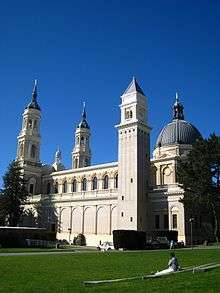
A new building was constructed in 1862 to replace the first frame building. In June 1863, the university awarded its first Bachelor of Arts degree. In 1880, the college moved from Market Street to a new site on the corner of Hayes Street and Van Ness Avenue (currently occupied by the Davies Symphony Hall). The third St. Ignatius College received moderate damage in the 1906 San Francisco earthquake, but was completely destroyed in the ensuing fire. The campus moved west, to the corner of Hayes and Shrader Streets, close to Golden Gate Park, where it occupied a hastily constructed structure known as The Shirt Factory (for its resemblance to similar manufacturing buildings of the era) for the next 21 years. The college moved to its present site on Fulton Street in 1927, on the site of a former Masonic Cemetery.[1]
To celebrate its diamond jubilee in 1930, St. Ignatius College changed its name to the University of San Francisco. The change from college to university was sought by many alumni groups and by long-time San Francisco Mayor James Rolph Jr.[14] A male-only school for most of its history, USF became fully coeducational in 1964, though women started attending the evening programs in business and law as early as 1927. In 1969, the high school division, already wholly separate from the university, moved to the western part of San Francisco and became St. Ignatius College Preparatory. In 1978, the university acquired Lone Mountain College.[14] October 15, 2005, marked the 150th anniversary of the university's founding.[15] In the fall of 2017, USF enrolled 11,080 undergraduate and graduate students in all of its programs housed in four schools (Law, Management, Education, Nursing and Health Professions) and one college (Arts and Sciences).[16]
Campus buildings
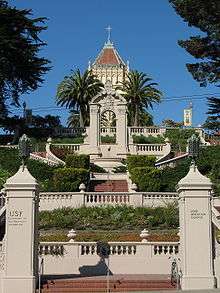
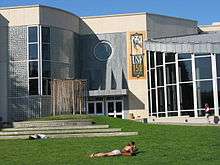
- Saint Ignatius Church (San Francisco) (1914)
- Kalmanovitz Hall (1927/2008)
- School of Education Building (1930)
- Lone Mountain (1932)
- Gleeson Library (1950) and the Geschke Learning Resource Center (1997)
- Toler Hall (1955)
- War Memorial Gymnasium (1958)
- Ulrich Field (1958)
- Fromm Hall (1959/2003)
- The Koret Law Center: Kendrick Hall (1962) and Dorraine Zief Law Library (2000)
- Lone Mountain North (1963)
- Gillson Hall (1965)
- Harney Science Center (1965)
- Hayes-Healy Hall (1966)
- University Center (1966)
- Cowell Hall (1969)
- Negoesco Stadium (1982)
- USF Koret Health and Recreation Center (1989)
- Loyola House (1999)
- 281 Masonic (2000)
- Pedro Arrupe Hall (2000)
- Loyola Village (2002)
- Malloy Hall (2004)
- John Lo Schiavo, S.J. Center for Science and Innovation (2013)
- Sobrato Center (2015)[17]
Organization and administration
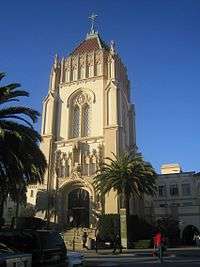
The University of San Francisco is chartered as a non-profit organization and is governed by a privately appointed board of trustees, along with the university president, the university chancellor, the university provost and vice-presidents, and the deans. The board currently has 43 voting members who serve three, three-year terms and is chaired by Stephen A. Hamill. The board of trustees elects a president to serve as the general manager and chief executive of the university. The current president (since August 1, 2014) is Paul J. Fitzgerald, S.J.[18] The president, according to USF Bylaws, is specifically responsible for articulating and advancing the Jesuit Catholic character of the university.[19]
USF's faculty and librarians are unionized. The University of San Francisco Faculty Association, a local of the California Federation of Teachers, represents its members in all matters concerning wages, benefits, and enforcing the Collective Bargaining Agreement. The USFFA is consulted by the USF administration on matters affecting the working conditions of the faculty and librarians. Economics professor Michael Lehmann was the founding president of the Union in 1975.
Academics
Rankings
| University rankings | |
|---|---|
| National | |
| Forbes[20] | 185 |
| U.S. News & World Report[21] | 96 |
| Washington Monthly[22] | 173 |
- USF was ranked 96th in the National University category in 2019 by U.S. News & World Report. USF was tied for 6th in undergraduate student ethnic diversity, and tied for 12th in the percentage of international students.[23]
- Washington Monthly ranked USF 30th out of 297 national universities in 2016 in service to the community.[24]
Global education
USF’s Center for Global Education advises students on international programs sponsored by USF or external organizations and schools and facilitates the process. USF has more than 40 institutional partnerships with other universities throughout the world, including in Argentina, Australia, Belgium, Brazil, the Czech Republic, Chile, China, El Salvador, England, Finland, France, Germany, Hungary, Ireland, Italy, Japan, Korea, Mexico, Netherlands, New Zealand, Nicaragua, the Philippines, Scotland, Singapore, South Africa, Spain, Taiwan, Thailand, and Uruguay. USF offers 133 semester-long international programs to its students. During the 2016-2017 academic year, 721 USF students earned academic credit through study abroad, exchange, intern, or social justice programs. Several USF students have received the Gilman Award for their participation in study abroad programs through the center.[25]
Reserve Officer Training Corps
USF has hosted an Army Reserve Officers' Training Corps program since 1936. ROTC, under the Military Science Department, adds specific electives to the core curriculum and can pay for a cadet's tuition.[26]
Student clubs and organizations
USF is home to over 90 clubs and organizations[27] including academic/professional, governance, cultural, service, social, political, athletic, and special interest. The missions and goals of USF's student clubs and organizations are to provide programs and services that support students' leadership development and promote student engagement in co-curricular activities.[28]
The Associated Students of the University of San Francisco (ASUSF) Senate is the student body governance organization responsible for organizing major campus events, voicing student concern, and reviewing the ASUSF budget.[29] USF's professional and academic organizations include chapters of many national and international groups, including the Professional Business Fraternity Delta Sigma Pi, the Lambda Iota Tau English Honor Society, Sigma Tau Delta, Jesuit Honor Society Alpha Sigma Nu, the National Society of Collegiate Scholars, National Political Science Honor Society Pi Sigma Alpha, Biological Honor Society Tri Beta, Accounting and Finance Honor Society Beta Alpha Psi and Psychology Honor Society Psi Chi. Professional organizations include the Family Business Association, Pre-Professional Health Committee, Pre-Dental Society, Hospitality Management Association, the Nursing Students Association, and the Entrepreneurship Club. Religious and spiritual organizations on campus include the Muslim Student Union, the USF chapter of InterVarsity Christian Fellowship, and the USF Hillel: The Foundation for Jewish Campus Life. USF leisure and hobby organizations include a chapter of many national organizations: Best Buddies, Outdoors and Environmental Education Club, USF Queer Alliance, San Quentin TRUST Alliance, Knitting for Neighbors, Back to the Roots, Surf and Skate Club, and the Animation Comics and Video Games (ACV) Club. Cultural and multicultural organizations around campus serve international students, Indian students, Black students (the Black Student Union), Latin American students and Hawaiian Students. There are also groups specifically for women of color and Latina women. Social justice clubs on campus include chapters of Amnesty International, School of the Americas Watch, Up 'til Dawn, and Invisible Children. There is also a Politics Society, Philosophy Club, Women in Media Club, and Women in Science Club.[30]
Student-produced media
The San Francisco Foghorn is the official student weekly newspaper and is sponsored by ASUSF. The Foghorn was founded in 1926, and was first called The Ignatian. In the 1930s when the college name was changed, the newspaper became the San Francisco Foghorn. The Foghorn has played a significant role on campus throughout the years, and has some notable alumni: Pierre Salinger, editor of the San Francisco Chronicle and Press Secretary for President John F. Kennedy; well-known author and historian Kevin Starr; and Leo T. McCarthy, former California Lieutenant Governor. In 1961 the Foghorn received the American Newspaper Publishers Association "Pacemaker Award". In 1998 Associated Collegiate Press named it "College Paper of the Year".
From 1977 USF radio station KUSF broadcast online until 2011 when its license was sold[31] to a Southern California-based classical radio station. KUSF had garnered international attention for its diverse musical programming, which varied from rock to hip hop to world music.[32] It received numerous awards[33] including public service awards[34] for its weekly community service series. USF's other radio station, KDNZ, is student-run.[35]
The University of San Francisco television station USFTV, founded in 2006[36] and entirely student-run, is broadcast on Channel 35 in the dormitories and around campus,[37] with news, sports, and cultural programming. In 2008, USFtv students collaborated with Wyclef Jean to create a music video for his song, "If I Was President".[38]
The Ignatian is USF's annual literary magazine published every spring, with a wide array of content from philosophical pieces to personal essays, short fiction, poetry, and photography.
Performing arts
USF has numerous student clubs for the performing arts, including a theater group (College Players), two-time Golden Gate Regional winning improvisational team (Awkward Silence), choir (ASUSF Voices), USF Don Marching Band, contemporary mass ensemble, and a dance program that focuses on social justice.
The College Players, founded in 1863, is considered one of the oldest student-run theater groups in the United States.[39] Their annual production of The Vagina Monologues gives all its proceeds to women's charities in the Bay Area.[40]
ASUSF Voices, in collaboration with the Performing Arts Department, contains a variety of choral ensembles, including jazz and popular.[41] The USF Contemporary Mass Ensemble (vocal and instrumental) are USF alumni who perform at Sunday Masses in St. Ignatius Church.[42] The USF dance program is affiliated with the Performing Arts and Social Justice Major. Students can enroll in traditional and modern dance classes and participate in the USF Dance Ensemble which includes, under professional choreographers.[43]
Greek life
All social sororities and fraternities recognized by the university must participate in the Greek Council, which tends to the development of these organizations and their members.[44] Chapters have some common mixers and socials, Thanksgiving potluck, Christmas clothing drive, Homecoming, and Greek Games.[45]
|
Social fraternities and sororities
Service
|
Academic, honor, and professional
|
Student body
Among the total USF student population in the fall of 2017, 19.9 percent were Asian American, 5.1 percent were African American, 20.6 percent were Latino, 0.2 percent were Native American, 0.7 percent were Native Hawaiian/Pacific Islander, 15.5 percent were international, 6.0 percent were of multiple races, and 28.0 percent were white. There was a 50.4 percent increase in the overall student enrollment from the fall of 2000 to the fall of 2017. By ethnicity, the number of Latino students increased by 233.0 percent during this period, the number of Asian American students increased by 78.8 percent, and the number of international students increased by 160.7 percent. The African American student population increased 36.4 percent, and the overall white student population decreased by 5.5 percent since 2000. The ethnic composition of all USF students in the fall of 2017 is displayed in Table 1.[48]
| Enrollment, 2000 | Enrollment, 2017 | % change | |
|---|---|---|---|
| Asian American | 1,232 | 2,203 | 78.8% |
| African American | 418 | 570 | 36.4% |
| Latino | 684 | 2,278 | 233.0% |
| Native American | 49 | 23 | -53.1% |
| Hawaii/ Pacific Islands | 128 | 80 | -37.5% |
| International student | 657 | 1,713 | 160.7% |
| White | 3,284 | 3,104 | -5.5% |
| Other | 914 | 440 | -51.9% |
| Total | 7,366 | 11,080 | 50.4% |
Notable students marked the early years of student diversity at the USF. Chan Chung Wing, whose parents had immigrated from near Canton, was in the first law class at then St. Ignatius College of Law. In 1929, the Filipino Ignatians was founded. In 1930, the African American Isaiah Fletcher was a starting tackle on the football team, years before most colleges became integrated. In 1936, Earl Booker, another African American, won the Intercollegiate Boxing Championship.[49]
International students made up 15.5% of the student body in the fall of 2017. International students have a special orientation period[50] and a variety of student groups like the International Student Association, Global Living Community,[51] an International Advisory Council, and an International Network Program.[52] USF sponsors an annual International Education Week with an international fair featuring consulates in the San Francisco area, storytelling opportunities, educational speakers, and a performance event called "Culturescape".[53]
Admissions
USF is categorized as a more selective university, according to U.S. News & World Report. The school's acceptance rate was 71% in the fall of 2017.[23][54] For freshman enrolling in the fall of 2016, the average high school grade point average (GPA) was 3.40 with a combined SAT score of 1141 for critical reading and math.[55]
Financial aid
In the 2016-2017 financial aid year, 72 percent of all undergraduates received some financial aid; 25 percent received Pell Grants. For full-time, freshman students in 2016–2017, 26 percent received Pell Grants, 82 percent institutional grants, and 83 percent some type of aid.[56]
For the 2017-18 year, tuition for full-time undergraduates is $45,760. The total estimated cost for one year, including fees, housing, and dining, is $60,580.[56]
Campus dining
USF offers the following dining options:[57]
- Market Café, the main campus' cafeteria, is located on the second floor of the University Center. It has several types of American, Italian, and Mexican food, and a salad bar. There is also a small store that sells drinks and snacks.[58]
- Crossroads Café is a student-run dining facility, located on the first floor of the University Center building.[58] The café (then Coffeehouse) started as a commuter students' lounge in the basement of the former Campion Hall, now Kalmanovitz Hall, in 1931.[59] The lounge was moved to the University Center Building when it was constructed in the fall of 1966.[60]
- Outtakes Café, also known as the Wolf and Kettle, is located on USF's Lone Mountain campus. Outtakes has two sections: a dining center, similar to a smaller cafeteria structure of tables, booths and chairs, and a small retail convenience store, offering fresh food and groceries.[58]
- Law Café is located on the School of Law Campus.[57]
- Club Ed Café is located on the bottom floor of USF's School of Education building.[57]
- Outtahere is the newest of the campus dining facilities, replacing Jamba Juice. Similar to Outtakes, it provides a small dining area that serves breakfast all day and a small convenience store that specializes in organics foods.
Athletics

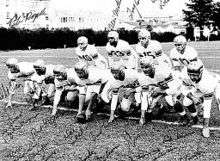
USF competes in NCAA Division I and is a charter member of the West Coast Conference, along with local rivals Santa Clara University and Saint Mary's College of California. Sports offered are men’s and women's basketball, cross country, golf, soccer, tennis, track and field, as well as men’s baseball and women's volleyball and sand volleyball. USF’s mascot is the Don and its colors are green and gold.
History
Athletics at USF dates back to its founding in 1855, when founder Anthony Maraschi, S.J., organized ball games as recreation for the first students. Intercollegiate competition dates back to 1907, when then St. Ignatius College began playing organized baseball, basketball, and rugby against other local colleges and high schools. Rivalries with neighboring Santa Clara University and Saint Mary's College of California have their origins in this early period.[14]
1951 USF Dons football team
The 1951 University of San Francisco Dons football team, coached by Joe Kuharich, went undefeated with a record of 9-0, and produced nine future NFL players. Five became NFL Pro-Bowlers, and Gino Marchetti, Ollie Matson, and Bob St. Clair later were inducted into the Pro Football Hall of Fame – a record for one college team. Also the team's Burl Toler became the first African American official in the NFL.[61] Future NFL Commissioner Pete Rozelle played a role as the Dons' Athletic Publicist. At the height of their success, due to the team having two African-American star players, Ollie Matson and Burl Toler, they were not invited to play in any of the college football bowl games hosted by the SEC (Southern Conference).[62] The team, less Toler and Matson, was invited to the Orange Bowl but declined. Guard Dick Columbini said, "'No, we're not going to leave ‘em at home’ ... ‘We're going to play with ‘em or we’re not going to play.’"[61] The USF Athletic Department was forced to drop its football program in 1952, due to a deficit in department funds.
Basketball
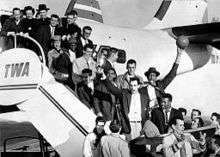
The men's basketball program won three national championships: the 1949 NIT Championship, with Don Lofgran as MVP, and the 1955 and 1956 NCAA National Championships, going undefeated in the 1956 season. Led by NBA Hall of Famers Bill Russell and K.C. Jones, the 1956 Dons became the first undefeated team to win a national championship, winning a then-record 60 games in a row from 1954 to 1956 before losing an exhibition game to the USA Men's Olympic Basketball team. Also of note, the 1954-1955 USF basketball teams became the first major college or university basketball team to win a national title with three African American starters (Russell, Jones, and Hal Perry).[14]
Soccer
The soccer program began at USF in 1931, and they succeeded from the start, winning five titles from 1932 to 1936. The team captain was All-American Gus Donoghue, who returned to the university as head coach in 1946, winning several titles, including a co-championship with Penn State in 1949.
At Donoghue's retirement in 1960, Stephen Negoesco, All-American and Holocaust survivor took over, having played under Donoghue in the 50s. He coached the team from 1962 to 2000, and led them to 540 wins and four national championships (1966, 1975, 1976, and 1980). Negoesco was inducted into the National Soccer Hall of Fame in 2003, having set a US record for games won in intercollegiate soccer competition.
Under Negoesco's successor, alumnus Erik Visser, the men's team earned the 2004, 2005, and 2008 WCC titles.[14]
Alumni
See also
Notes
- 1 2 Ziajka, Alan. Lighting the City, Changing the World of the Science at the University of San Francisco. San Francisco: University of San Francisco, Association of Jesuit University Presses, 2014.
- ↑ As of May 31, 2017. MOSSADAMS. "Report of Independent Auditors and Financial Statements.
- 1 2 3 4 5 "USF Quick Facts" (PDF). University of San Francisco, Center for Institutional Planning and Effectiveness. Retrieved September 9, 2016.
- ↑ "University of San Francisco Graphic Standards Manual" (PDF).
- ↑ http://www.usfdons.com/
- ↑ mjuarez3 (2015-05-05). "Branch Campuses". University of San Francisco. Retrieved 2017-11-07.
- ↑ henke (2016-09-06). "Downtown Campus". University of San Francisco. Retrieved 2017-11-07.
- ↑ McKeel, Jenny (2015-05-27). "Orange County". University of San Francisco. Retrieved 2017-11-07.
- ↑ mjuarez3 (2015-05-05). "Pleasanton Campus". University of San Francisco. Retrieved 2017-11-07.
- ↑ mjuarez3 (2015-05-05). "Presidio Location". University of San Francisco. Retrieved 2017-11-07.
- ↑ mjuarez3 (2015-05-05). "Sacramento Campus". University of San Francisco. Retrieved 2017-11-07.
- ↑ mjuarez3 (2015-05-05). "San Jose Campus". University of San Francisco. Retrieved 2017-11-07.
- ↑ mjuarez3 (2015-05-05). "Santa Rosa Campus". University of San Francisco. Retrieved 2017-11-07.
- 1 2 3 4 5 6 Ziajka, Alan. Legacy & Promise: 150 years of Jesuit education at the University of San Francisco. San Francisco: University of San Francisco, Association of Jesuit University Presses, 2005.
- ↑ "USFCA.edu". Archived from the original on 2009-06-06. Retrieved 2009-05-14.
- ↑ Tom, Marlene (2015-05-04). "Facts & Statistics". University of San Francisco. Retrieved 2017-11-07.
- ↑ "USF General Catalog". University of San Francisco.
- ↑ McDonald, Gary (2014-07-15). "Introducing USF's New President". USF Magazine. University of San Francisco. Archived from the original on 2014-09-24. Retrieved 2014-12-16.
- ↑ "Bylaws of the University of San Francisco". Archived from the original on 2009-05-16. Retrieved 2009-05-07.
- ↑ "America's Top Colleges". Forbes. July 5, 2016.
- ↑ "Best Colleges 2017: National Universities Rankings". U.S. News & World Report. September 12, 2016.
- ↑ "2016 Rankings - National Universities". Washington Monthly. Retrieved September 6, 2016.
- 1 2 "University of San Francisco Rankings". U.S. News and World Report. November 2017. Archived from the original on 2011-03-20.
- ↑ "2016 College Guide and Rankings". Washington Monthly. Retrieved 2017-04-14.
- ↑ Chin, Steven (2014-06-24). "USF Students and Alumni Named Fulbright and Gilman Scholars". University of San Francisco. Retrieved 2017-04-06.
- ↑ "About Army ROTC". Goarmy.com. Archived from the original on August 22, 2008. Retrieved 2008-12-09.
- ↑ "USFCA.edu". USFCA.edu. 2013-08-29. Archived from the original on 2013-10-04. Retrieved 2013-10-08.
- ↑ "Student Leadership and Engagement". Retrieved December 16, 2014.
- ↑ "Associated Students of USF". Archived from the original on 2014-12-17. Retrieved December 16, 2014.
- ↑ "Search Results | University of San Francisco". www.usfca.edu. Retrieved 2017-09-26.
- ↑ "USFCA.edu". Archived from the original on 2011-01-22. Retrieved 2011-01-19.
- ↑ "KUSF International Fan Mail". Kusf.org. Archived from the original on October 20, 2007. Retrieved 2008-12-09.
- ↑ "KUSF Awards". Kusf.org. Archived from the original on October 20, 2007. Retrieved 2008-12-09.
- ↑ "KUSF Public Service Awards". Kusf.org. Archived from the original on October 20, 2007. Retrieved 2008-12-09.
- ↑ "About KDNZ". Usfca.edu. Retrieved 2008-12-09.
- ↑ Emma, Kathleen. "Student-Run TV Station Launches Wednesday, February 22." San Francisco Foghorn. 16 February 2006
- ↑ "USFtv Gears Up for First Cablecast of the Semester | Foghorn Online". Foghorn.usfca.edu. Retrieved 2008-12-09.
- ↑ "{title}". Archived from the original on 2008-12-02. Retrieved 2008-12-06.
- ↑ ASUSF College Players sle.orgsync.com
- ↑ "foghorn.usfca.edu". foghorn.usfca.edu. 2009-02-18. Retrieved 2013-10-08.
- ↑ "USF music program". Archived from the original on 2008-12-02. Retrieved 2009-05-07.
- ↑ "USF Contemporary Mass Ensemble". Archived from the original on 2008-12-02. Retrieved 2009-05-07.
- ↑ "USF Dance Program". Archived from the original on 2010-11-16. Retrieved 2011-03-18.
- ↑ "Club Orientation". Retrieved 2008-12-04.
- ↑ "USF greek council". Archived from the original on 2009-02-28. Retrieved 2009-05-09.
- ↑ "Greek Life chapters". Usfca.edu. Archived from the original on 2013-10-04. Retrieved 2013-10-08.
- ↑ "Campus Life". Usfca.edu. Archived from the original on 2013-10-04. Retrieved 2013-10-08.
- 1 2 Ziajka, Alan (November 2017). "USF Fact Book and Almanac, 2017 Mid-Year Edition" (PDF). University of San Francisco.
- ↑ Ziajka, Alan. “Student Ethic Diversity Since 1855.” Bridging Time: The History of Newsletter of the University of San Francisco, Volume 1, Issue 1, January 20, 2015.
- ↑ "USF - GO Team-New Student Orientation". Usfca.edu. Archived from the original on 2009-01-02. Retrieved 2008-12-09.
- ↑ "USF - Global Living Community". Usfca.edu. Archived from the original on 2008-12-28. Retrieved 2008-12-09.
- ↑ "USF - International Network Program". Usfca.edu. Archived from the original on 2008-12-28. Retrieved 2008-12-09.
- ↑ "{title}". Archived from the original on 2008-12-28. Retrieved 2008-12-09.
- ↑ http://colleges.usnews.rankingsandreviews.com/best-colleges/university-san-francisco-1325
- ↑ "Facts & Statistics". USFCA.
- 1 2 "Tuition and Fees Schedule for Academic Year 2017-18". Retrieved March 20, 2017.
- 1 2 3 "Café Bon Appétit Dining Hours". USFCA. November 2017. Archived from the original on 2006-12-27. Retrieved 2017-09-26.
- 1 2 3 "Campus Dining". USFCA. November 2017.
- ↑ University of San Francisco Handbook, 1949
- ↑ University of San Francisco Alumnus, October 1966
- 1 2 Lukacs, John D. "Waiting for the Perfect Ending", USA Today, June 24, 2003. Sports 8C.
- ↑ Clark, Kristine. "Undefeated, United and Uninvited: A Documentary of the 1951 University of San Francisco Dons Football Team". Griffin Publishing, May 2002.
| Wikimedia Commons has media related to University of San Francisco. |
References
- Downs, Tom. (2007). Walking San Francisco: 30 Savvy Tours Exploring Steep Streets, Grand Hotels, Dive Bars, and Waterfront Parks. Berkeley: Wilderness Press.
- Ganz, Liz and Rick Newby. (1999). Walking San Francisco. Montana: Morris Book Publishing, LLC.
- McGloin S.J., John Bernard. (1972). Jesuits by the Golden Gate: the Society of Jesus in San Francisco, 1849-1969. University of San Francisco.
- Pollack, Chris. (2001) San Francisco's Golden Gate Park: A Thousand and 17 acres (6.9 ha) of Stories. Portland, Oregon: WestWinds Press.
- The University of San Francisco General Catalog 2014-2015.
- Ziajka, Alan. (2005). Legacy & Promise: 150 years of Jesuit education at the University of San Francisco. San Francisco: University of San Francisco, Association of Jesuit University Presses.
- Ziajka, Alan. (2012). The University of San Francisco School of Law: 100 Years of Educating for Justice. San Francisco: University of San Francisco, Association of Jesuit University Presses.
- Ziajka, Alan. (2014). Lighting the City, Changing the World: A History of the Sciences at the University of San Francisco. San Francisco: University of San Francisco, Association of Jesuit University Presses.
